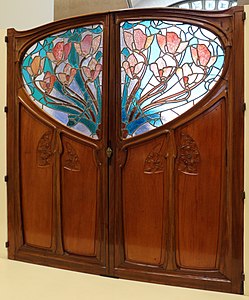Eugène Vallin

Eugène Vallin (French pronunciation: [øʒɛn valɛ̃]; 1856 – 21 July 1922) was a French furniture designer and manufacturer, as well as an architect.
Life and career
Vallin was born at Herbéviller, and studied at the École des Beaux-Arts in Nancy. He was apprenticed in the studio of his uncle, also a furniture maker, beginning in 1881.
His first projects were for church interiors and furniture but quickly he became a disciple of Art Nouveau, in part under the influence of Émile Gallé, for whom he created the door of Gallé's new studios. But he was most famous for his furniture, designing entire living rooms and dining room ensembles for notable personalities in Nancy, including Jean-Baptiste "Eugène" Corbin, Charles Masson, Albert Bergeret, and others.
In 1895-6, he built a new studio and his own house on the Boulevard Lobau in Nancy, which became what is now considered (in a crude form) the first Art Nouveau edifice in the city with the help of his friend, architect Georges Biet. In return, Vallin was responsible for the furniture that adorned Biet's house at 22, rue de la Commanderie, in Nancy.
In 1901, along with Antonin Daum and Louis Majorelle, Vallin became one of three vice-presidents of the board of directors of the École de Nancy.
In architecture, he was one of the pioneers of construction in concrete reinforced by steel, a technique he used for the construction of the pavilion of the École de Nancy at the International Exposition of the East of France in 1909. He died in Nancy.
ChatGPT
Works
Church furnishings
Although not widely known for this activity, Vallin nevertheless designed some organ caseworks for churches in Lorraine:
- in Meurthe-et-Moselle:
- at the Church of Saint-Léon-IX in Nancy (neo-Gothic casework), Church of Saint-Nicolas in Nancy, Church of Notre-Dame-de-Bonsecours in Nancy (Louis XV-style confessional),[1]
- at the Church of Saint-Jacques in Lunéville (choir organ),
- at Einville-au-Jard: benches, pulpit (removed), and choir woodwork,
- at Ancerviller: benches, pulpit;
- in Meuse:
- in Euville and Saint-Mihiel (choir organ in the Saint-Mihiel Abbey),
- at the Church of Saint-Georges in Buxières-sous-les-Côtes, an oak organ casework created in 1898, listed on the Supplementary Inventory of Historic Monuments in 1992;
- in Vosges: Thaon-les-Vosges (originating from the Abbey of Notre-Dame d'Autrey).
- Confessional in Notre-Dame-de-Bonsecours.
- Saint-Michel Abbey.
- Armorial and ornate support for the organ in the Church of Saint-Léon-IX.
Architectural works
- Maison et Atelier Vallin built in 1895 at 6-8 Boulevard Lobau in Nancy
- Maison du peuple built in 1902 at 2 Rue Drouin in Nancy
- Immeuble Georges Biet built in 1902 in collaboration with Georges Biet at 22 Rue de la Commanderie in Nancy
- Hôtel de ville d'Euville built in 1901–1903 in collaboration with Henry Gutton and Joseph Hornecker
- Immeuble Margo built in 1906 in collaboration with Paul Charbonnier at 86 Rue Stanislas in Nancy
- Pharmacie Malard built in 1907 at 23 Place Charles-de-Gaulle in Commercy[2]
- Maison et Atelier Vallin.
- Maison du Peuple.
- Immeuble Georges Biet.
- Hôtel de ville d'Euville.
- Immeuble Margo.
- Pharmacie Malard.
Cabinetmaking
- Bed and bedside table
Musée d'Orsay - Dining room
Musée de l'École de Nancy - Detail of the dining room
Musée de l'École de Nancy.
References
- ^ L'Ecole de Nancy, 1889-1909: Art nouveau et industrie d'art, Réunion des musées nationaux, 1999, ISBN 2-7118-3843-9
- ^ Guides, Fodor's Travel (2014-09-30). Fodor's France 2015. Fodor's Travel. ISBN 978-0-8041-4294-6.













